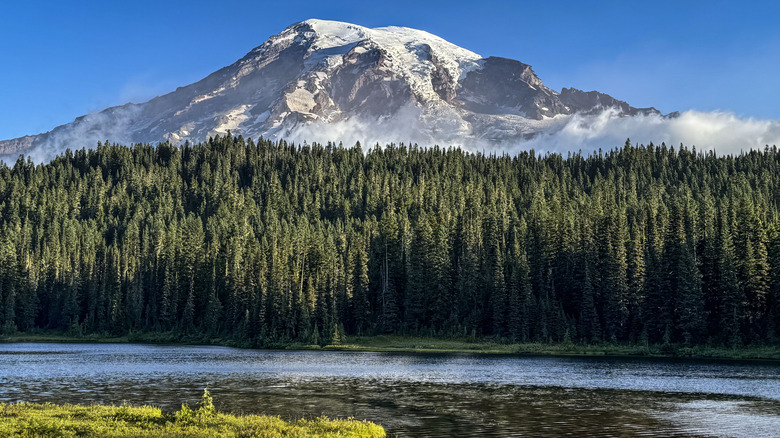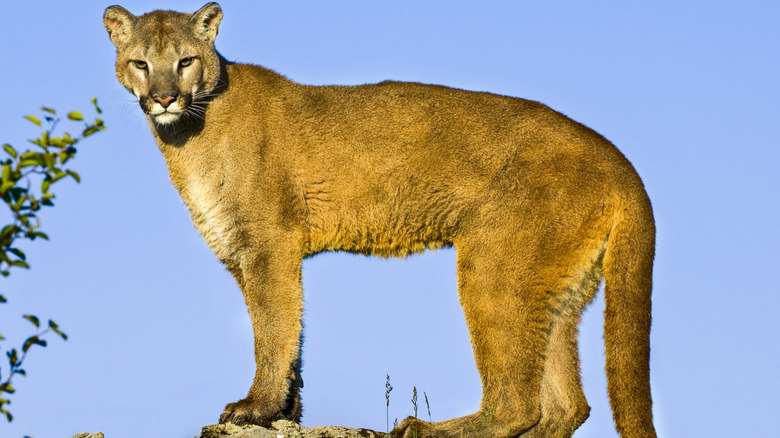Beware Of These Dangerous Creatures When Visiting Mount Rainier National Park
We may receive a commission on purchases made from links.
Rising to over 14,400 feet, Mount Rainier is the fifth tallest mountain in the Lower 48. Given it is also more glaciated than any U.S. mountain outside of Alaska and an active volcano, it's easy to see how this iconic mountain in Washington State is fraught with potential danger. However, some of the most immediate concerns for visitors is the wildlife living in the area surrounding the mountain. Bears and mountain lions, along with a variety of smaller mammals and insects, make up the list of dangerous creatures to beware of when visiting Mount Rainier National Park.
While Mount Rainier National Park has no venomous snakes, there are other smaller species to keep an eye out for when adventuring in the area. Black widows, though not common, do exist here. Tiny ticks and mosquitoes can actually cause some major issues for those who come unprepared, particularly during the summer months. To reduce the risk, it is a good idea to always wear long-sleeve clothing when hiking and spray your clothing with repellent. You should also be sure to carry a tick key, check yourself after hikes, and promptly remove any ticks.
There are also several small mammals to watch out for when visiting Mount Rainier National Park. Bats, which are relatively common here, can be rabid. While it is rare to be bitten by a rabid bat, if you encounter any of these flying mammals that seem to be acting odd, you should keep your distance and notify a park ranger. Deer mice are another small mammal which you should avoid contacting, as they can potentially transmit hantavirus. Even cuddly looking small mammals such as squirrels and chipmunks should not be handled or fed, as they can and will bite.
Mount Rainier National Park has a large black bear population
Unlike some of the neighboring areas in the Northwestern US, including other portions of Washington State, Mount Rainier National Park does not have a population of grizzly bears. However, there is a large population of black bears which, despite their somewhat docile disposition, are still considered a dangerous type of bear. So, visitors to Mount Rainier National Park are encouraged to carry and know how to use bear spray, such as SABRE Frontiersman, and practice bear safety protocol while adventuring.
Black bears in Mount Rainier National Park can actually range from reddish brown to black in color, and are often seen along the trails and roadways, especially in areas that have berries or other food sources. So, it is important to be very aware of your surroundings and avoid areas where bears are known to be active or are possibly feeding. It is also helpful to make noise to avoid bears when hiking by wearing a Coghlan's Bear Bell or similar device or holding a conversation with your companions as you move. Proper food storage is also essential in order to avoid bears, whether you're hiking or camping.
If you happen to spot a bear, give it plenty of space — typically the length of a football field is recommended. Additionally, do not run or attempt to climb a tree in order to flee from a bear. This can trigger a predatory reaction in the bear and they are both faster and better climbers than humans. Instead, stay calm and speak firmly to the bear while maintaining eye contact and moving away slowly. Should the bear aggressively charge within 30 to 40 feet, utilize your bear spray. If it continues to attack, fight back.
Big cats and other carnivores are plentiful around Mount Rainier
Black bears aren't the only dangerous creature walking around Mount Rainier National Park. There are a handful of small to medium sized carnivores, including bobcats, coyotes, and foxes. While each of these animals can inflict harm on humans, they are typically skittish and shy. Making noise while hiking is usually enough to ensure they keep a safe distance away. If you encounter any of them, utilizing what is commonly referred to as coyote hazing will usually send them on their way. This includes making yourself look as large as possible, waving your arms overhead, making noise, and tossing objects in the direction of the animal.
Mountain lions, on the other hand, are a much more formidable threat. These big cats spend most of their time in the forested areas of the park. Although they are certainly around, they are very rarely seen, as they are masters of stealth, concealment, and surprise. While attacks are relatively rare, they do happen. According to official statistics, there have been 22 attacks and 2 fatalities attributed to mountain lions in Washington state over the past century and a quarter.
Since these big cats do prowl the park, you should keep an eye out for signs a mountain lion may be near, such as scat, tracks, or claw marks. As is the case with bears, safety is increased by alerting these predators to your presence, so make noise while moving through the park. It is also best to hike in groups. If a lion is sighted, stand your ground. Do not crouch or bend over, but instead make yourself look as large as possible, wave your hands over your head, and make noise. Should the cat attack, fight back, using whatever you can grab as a weapon.


